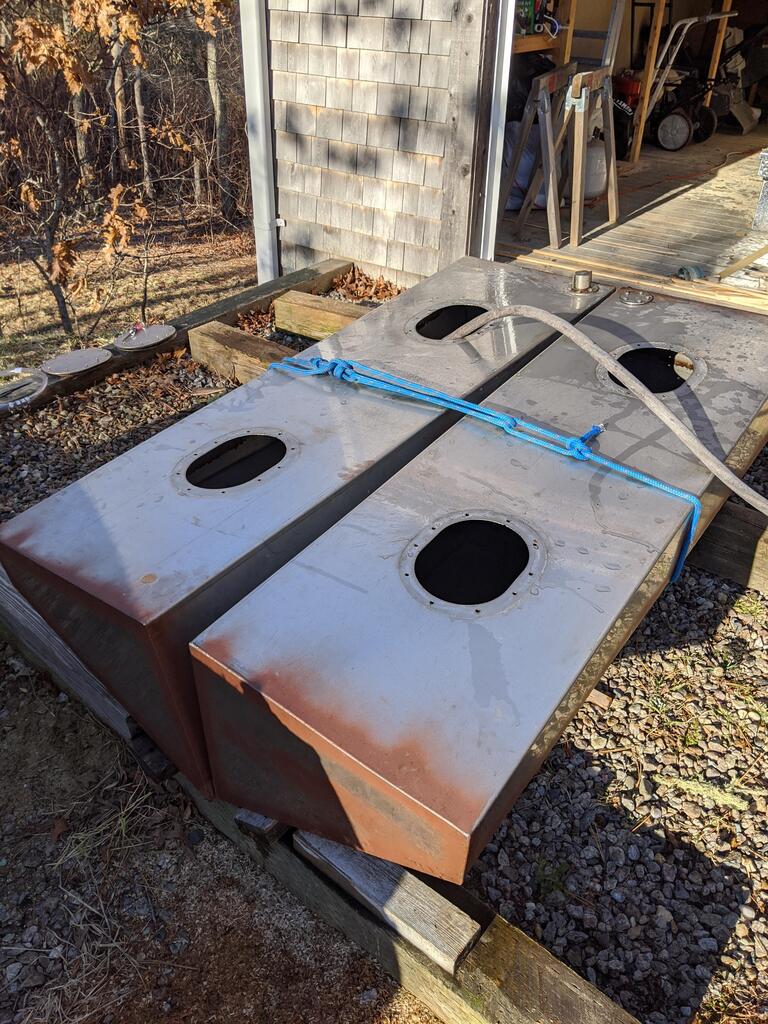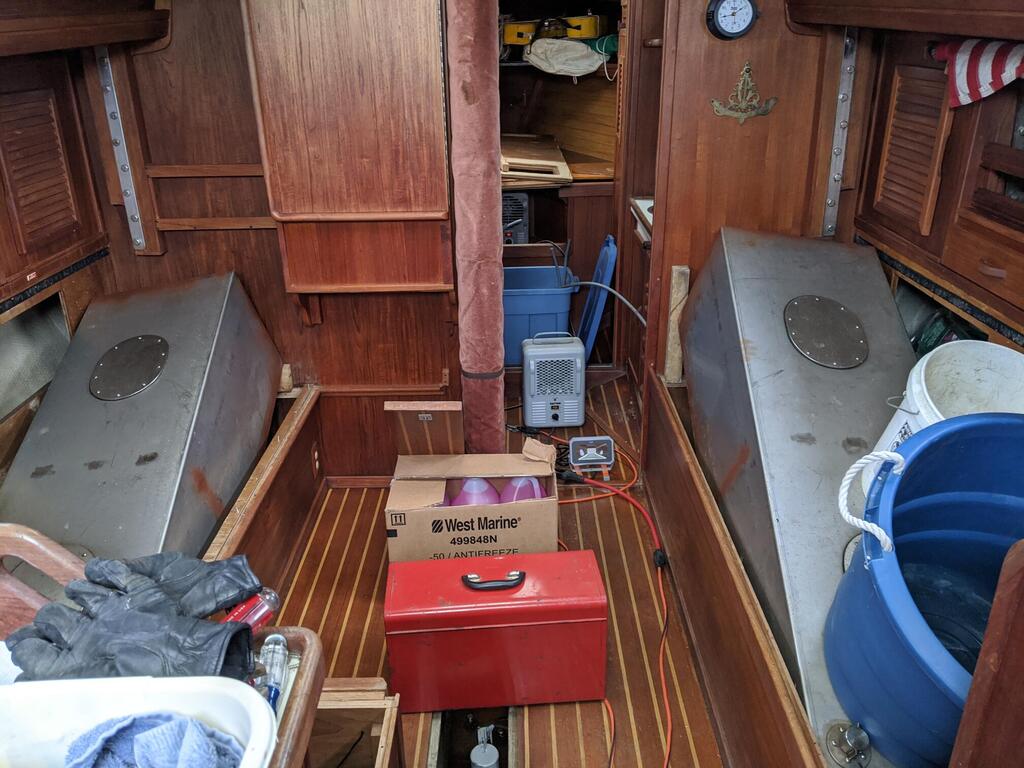Completed Plumbing Changes
Very little plumbing work has been completed.
Original plumbing condition
The water tanks were both clogged with black muck which was presumed to be dead algea. The domestic water would only flow at a dribble. One tank was half full and completely clogged. The other was less full and nearly completely clogged. Lines from the tanks to the pressure pump were also clogged. Other lines are too small and also clogged. Water lines cross the bilge multiple times where they cannot be drained and are not supported at all. Fittings and lines use multiple materials with bronze, maralon, and inexpensive plastic used for fittings and line is a mix of some ½" clear tubing and mostly grey inexpensive semi-rigid plastic line that appear to be ¼" or slightly larger. The plastic line was about ½" OD and in places spliced with ½" line by putting the smaller line inside the larger and using hose clamps.


Removing, cleaning, and reinstalling water tanks
Due to poor install (apparently a previous owner's work) it was impossible to detach lines at the tank without partially lifting the tank. This created a chicken and egg problem as one of the tanks, with 200 lbs of water in it was very difficult to lift. With wooden blocks and short pieces of wood used as levers enough clearance was created to detach hoses.
After detaching tank hoses, the tanks still did not drain. The plastic gate valves and tank itself were clogged. This was solved by blowing out the clogs using compressed air.
The tank lines were the smaller grey semi-rigid plastic. The shut off valves were grey plastic gate valves the look like inexpensive sink shutoffs. Part of the reason the hoses could not be removed is there was a short male to male section, a reducer, the valves, another male to male section, and then a tee and barbs on port side and an elbow and barb on starboard. Three different materials were used in these fittings (none of them stainless steel to match the tank). This was long and made the barb difficult to reach. The elbow and barb fitting could not be turned until the tank was lifted. On the port side some fittings were epoxied rather than using plumbing tape and so were destroyed in disassembly.
The tanks were temporarily removed and brought home. They were be filled with water with some bleach to disolve remaining algea, then emptied and power washed through the two inspection ports.
The fittings have been replaced with stainless steel. First a ball valve with male on one end, then a barb. A length of ½" reinforced tubing leads from each tank to a tee in the bilge area between tanks. A set of tees and elbow and three ball valves were used. One ball valve with barb and short hose drains into the bilge at the lowest point in this assembly. After draining tanks, both tanks can be closed and the drain hose put into a container of antifreeze to pump through the domestic water system before draining to winterize. This hose can also be used as a place to blow compressed air through the pumps one way valves. The remaining two valves lead to a pressure pump on port and starboard side.
Domestic water pumps
Two pressure pumps are used, one on each side forward of the tanks. The port side will serve the galley. The starboard side will serve the vanity sink and shower.
Fore and aft of each tank is a small block to hold the tank in place. This block is 2½" wide. There is 8" from the block to the cabinetry on the starboard side and 8¼" on the port side. Forward of either tank is about 4½" starboard and 4⅜" port plus the width of the block. A corner of each tank rubs on the hull. The blocking for the tanks will be improved to hold the tanks slightly higher. This will also improve access to the fittings on the tanks.
There is room forward of the two water tanks where the two domestic water pressure pumps have been installed.
Expansion tanks
Two expansion tanks and two small domestic hot water heaters will be used. These have been purchased but not yet installed.
A Groco PST-1 has 8" diameter, 12.63" length and provides a ½ gallon drawdown in a 2 gallon tank. Other accumulator tanks are available with as little as 4" to 5" diameter.
Water heaters
Some of the smaller hot water heaters, with 3-4 gallon capacity, are expensive and not much smaller than the older 6 gallon. These are better insulated and more efficient resulting in the larger size and higher cost.
The 3 gallon Seaward (Whale) S360EW is 13¼"Hx13"Wx13¾H so would fit in this space and has a 12V 300W heating element. A drawback is it costs over $500. The Isotemp SPA 15 is a 115V 750W 4 gallon heater in stainless steel. It is cylindrical with a 12.7" diameter and 21¼" length. These are about $600.
It might be possible to convert the 12V water heater to 24V or 48V using the Dernord 24V 600W Heating Element or the DERNORD 48V 1000W Screw-In Foldback Water Heater Element as long as the water heater uses a 1" NPT heating element.
Two new Seaward 12V 300W water heaters have been purchased but not yet installed.
